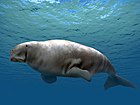| Dioplotherium Temporal range: | |
|---|---|
 | |
| Skull of D. manigaulti, Florida Museum of Natural History | |
| Scientific classification | |
| Domain: | Eukaryota |
| Kingdom: | Animalia |
| Phylum: | Chordata |
| Class: | Mammalia |
| Order: | Sirenia |
| Family: | Dugongidae |
| Subfamily: | Dugonginae |
| Genus: | † Dioplotherium Cope, 1883 |
| Species | |
| |
Dioplotherium is an extinct genus of mammal known from Neogene deposits in the Southeastern United States. [1]

